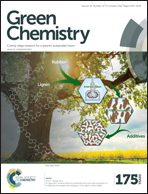Using iSUSTAIN™ to validate the chemical attributes of different approaches to the synthesis of tacn and bridged (bis)tacn ligands†
Abstract
Using green chemistry principles, alternative approaches for the synthesis of commercially important aza-macrocyclic tacn and (bis)tacn derivatives have been investigated to determine the step average and overall efficiency of these synthetic methods. Based on analytical metrics derived from the iSUSTAIN™ toolkit, the Richman–Atkins route for the synthesis of tacn (1) was found to be the more efficient; however an alternate route was shown to be preferable for the synthesis of (bis)tacn (2) compounds. The outcome of this study documents the importance of rigorous analysis of synthetic procedures for such aza-macrocyclic compounds in terms of their green chemistry attributes, in order to delineate how alternative synthetic methods can be ranked, more innovative procedures selected to improve productivity and yield, and synthetic methods deployed to achieve greater levels of waste reduction, reduced use of hazardous chemicals and lower environmental impact.


 Please wait while we load your content...
Please wait while we load your content...